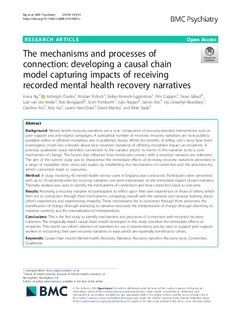| dc.contributor.author | Ng, Fiona | |
| dc.contributor.author | Charles, Ashleigh | |
| dc.contributor.author | Pollock, Kristian | |
| dc.contributor.author | Rennick-Egglestone, Stefan | |
| dc.contributor.author | Cuijpers, Pim | |
| dc.contributor.author | Gillard, Steve | |
| dc.contributor.author | van der Krieke, Lian | |
| dc.contributor.author | Bongaardt, Rob | |
| dc.contributor.author | Pomberth, Scott | |
| dc.contributor.author | Repper, Julie | |
| dc.contributor.author | Roe, James | |
| dc.contributor.author | Llewellyn-Beardsley, Joy | |
| dc.contributor.author | Yeo, Caroline | |
| dc.contributor.author | Hui, Ada | |
| dc.contributor.author | Hare-Duke, Laurie | |
| dc.contributor.author | Manley, David | |
| dc.contributor.author | Slade, Mike | |
| dc.date.accessioned | 2020-02-04T12:39:59Z | |
| dc.date.available | 2020-02-04T12:39:59Z | |
| dc.date.created | 2020-01-31T08:55:26Z | |
| dc.date.issued | 2019 | |
| dc.identifier.citation | BMC Psychiatry. 2019, 19 (413). | nb_NO |
| dc.identifier.issn | 1471-244X | |
| dc.identifier.uri | http://hdl.handle.net/11250/2639581 | |
| dc.description | Open Access This article is distributed under the terms of the Creative Commons Attribution 4.0 International License which permits unrestricted use, distribution, and reproduction in any medium, provided you give appropriate credit to the original author(s) and the source, provide a link to the Creative Commons license, and indicate if changes were made | nb_NO |
| dc.description.abstract | Background
Mental health recovery narratives are a core component of recovery-oriented interventions such as peer support and anti-stigma campaigns. A substantial number of recorded recovery narratives are now publicly available online in different modalities and in published books. Whilst the benefits of telling one’s story have been investigated, much less is known about how recorded narratives of differing modalities impact on recipients. A previous qualitative study identified connection to the narrator and/or to events in the narrative to be a core mechanism of change. The factors that influence how individuals connect with a recorded narrative are unknown. The aim of the current study was to characterise the immediate effects of receiving recovery narratives presented in a range of modalities (text, video and audio), by establishing the mechanisms of connection and the processes by which connection leads to outcomes.
Method
A study involving 40 mental health service users in England was conducted. Participants were presented with up to 10 randomly-selected recovery narratives and were interviewed on the immediate impact of each narrative. Thematic analysis was used to identify the mechanisms of connection and how connection leads to outcome.
Results
Receiving a recovery narrative led participants to reflect upon their own experiences or those of others, which then led to connection through three mechanisms: comparing oneself with the narrative and narrator; learning about other’s experiences; and experiencing empathy. These mechanisms led to outcomes through three processes: the identification of change (through attending to narrative structure); the interpretation of change (through attending to narrative content); and the internalisation of interpretations.
Conclusions
This is the first study to identify mechanisms and processes of connection with recorded recovery narratives. The empirically-based causal chain model developed in this study describes the immediate effects on recipients. This model can inform selection of narratives for use in interventions, and be used to support peer support workers in recounting their own recovery narratives in ways which are maximally beneficial to others. | nb_NO |
| dc.language.iso | eng | nb_NO |
| dc.rights | Navngivelse 4.0 Internasjonal | * |
| dc.rights.uri | http://creativecommons.org/licenses/by/4.0/deed.no | * |
| dc.title | The mechanisms and processes of connection: developing a causal chain model capturing impacts of receiving recorded mental health recovery narratives | nb_NO |
| dc.type | Journal article | nb_NO |
| dc.type | Peer reviewed | nb_NO |
| dc.description.version | publishedVersion | nb_NO |
| dc.rights.holder | © The Author(s). 2019 | nb_NO |
| dc.source.pagenumber | 15 | nb_NO |
| dc.source.volume | 19 | nb_NO |
| dc.source.journal | BMC Psychiatry | nb_NO |
| dc.source.issue | 413 | nb_NO |
| dc.identifier.doi | https://doi.org/10.1186/s12888-019-2405-z | |
| dc.identifier.cristin | 1787461 | |
| cristin.unitcode | 222,56,3,0 | |
| cristin.unitname | Institutt for helse-, sosial- og velferdsfag | |
| cristin.ispublished | true | |
| cristin.fulltext | original | |
| cristin.qualitycode | 1 | |

